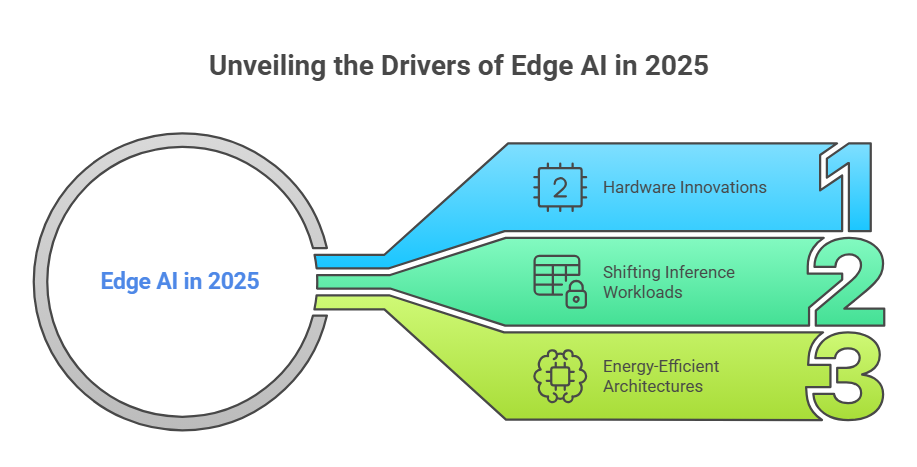The Evolution of AI in Edge Computing: Empowering Real-Time Decision-Making in 2025
The world is no longer waiting for information to travel to the cloud and back. In 2025, businesses and everyday users alike expect decisions to be made in the blink of an eye whether it’s a car avoiding an obstacle, a doctor monitoring a patient remotely, or a factory machine preventing a breakdown before it happens. This is where the power of AI in edge computing shines. By bringing intelligence directly to devices and sensors, organizations can unlock the speed, privacy, and resilience needed for modern operations.
The shift isn’t just technological it’s transformative. Companies are rethinking how they process and act on data, moving from reactive approaches to proactive, real-time decision-making. At the center of this evolution are specialized partners: the modern AI development company. These innovators are enabling businesses to harness edge AI, ensuring that analytics, insights, and actions happen instantly, reliably, and securely.
Edge AI in 2025: What’s Fueling It?
Hardware Innovations
AI hardware has improved dramatically with edge-deployable specialized chips and processors. Small accelerators now allow AI models to execute on everything from smart cameras to wearables, delivering quicker performance while drawing less power.
Shifting Inference Workloads
Inference, where AI models make predictions is more and more occurring directly on devices. From smartphones to self-driving cars, this is enabling real-time decision-making without cloud connectivity.
Energy-Efficient Architectures
Emerging chip architectures based on the human brain are making energy-efficient, always-on sensing possible. Neuromorphic techniques allow IoT devices, smart home appliances, and drones to handle sophisticated data streams in real time, increasing battery life while enhancing responsiveness.

Why Edge AI Matters: Core Advantages
Speed and Real-Time Analytics
Edge AI ends the latency by processing information in situ. In high-stakes use cases like emergency medicine or industrial control, this instant ability to act on insights can mean the difference between life and death and help lower the risk of operations.
Bandwidth Optimization and Privacy
By holding data locally, edge computing minimizes network congestion and adds a layer of security. Sensitive data, like health or personal financial information, can be held local—addressing compliance and sovereignty needs
Resilience and Reliability
Edge devices can continue functioning even with unstable or lost connectivity. This resilience makes them indispensable for industries like transportation, defense, and energy where downtime is not an option.
The Growing Role of AI
Market Momentum of Edge AI
The market for edge AI is seeing explosive expansion. Global adoption is expected by analysts to compound at more than 20% per annum over the next decade, reaching tens of billions of dollars by 2030. Edge computing, which was previously viewed as auxiliary, is increasingly becoming the foundation of contemporary digital infrastructure.
Edge Computing Takes Center Stage
Most enterprise data will be processed at the edge by 2025, and not on centralized servers. This is propelled by lower latency requirements, better data privacy, and performance assurance in mission-critical applications. With organizations getting modernized, the use of edge computing in 2025 is surging ever higher.
Learn More: The Growing Role of AI
Use Cases That Highlight Edge AI’s Impact
- Autonomous Vehicles
Self-driving cars rely on split-second analysis. Edge AI enables them to process sensor data locally, ensuring safer navigation in real time.
- Healthcare and Telemedicine
Wearable devices and monitoring equipment process patient vitals in real-time at the edge, enabling remote care and timely interventions.
- Industrial Automation
Intelligent factories utilize predictive maintenance through edge AI. Edge AI detects issues before failures, cutting costs and downtime.
- Public Safety and Drones
AI-powered drones, with edge processing, provide real-time situational awareness for mapping, inspection, and disaster response.
Innovations in Architecture & Frameworks
Distributed AI Processing
New paradigms offload machine learning tasks to devices, edge servers, and the cloud. Distributed in a balanced manner, it accelerates response times, minimizes network traffic, and maximizes energy efficiency.
Smart City Infrastructure
Edge AI is emerging as the underpinning of smart cities. From traffic management to climate monitoring, real-time analytics improve public safety, decongest streets, and urban services become more efficient.
On-Device Optimization
Model compression and quantization methods now enable high-performance AI models to execute flawlessly on low-power devices. This makes it possible to have AI-powered features on smartphones, cameras, and sensors previously achievable only in the cloud.
Strategic Partnerships: The Role of an AI Development Company
For organizations looking to adopt edge AI, partnering with an experienced AI development company is crucial. Such companies bring:
- Expertise in building edge-optimized AI architectures.
- Knowledge of deploying lightweight yet powerful models on constrained devices.
- Integration capabilities between cloud systems and edge networks.
- Security and compliance strategies tailored to sensitive data environments.
Working with the right partner ensures that AI solutions are not only technically sound but also scalable, secure, and aligned with long-term business goals.
Challenges in Implementing Edge AI
|
Looking Ahead: Predictions for Edge AI
- Mainstream Device-Level AI: Everyday devices will take on more intelligent tasks, offering personalized and instant experiences.
- Smart Ecosystems: Cities and industries will be increasingly powered by AI-driven infrastructures at the edge.
- Energy-Efficient Processing: Neuromorphic and low-power chips will expand AI’s reach into billions of connected devices.
- Autonomous Adaptation: Devices will not only process data but also learn and adapt on the fly ushering in a new era of real-time autonomy.
Final Thoughts
The development of AI at the edge has revolutionized how data is processed, decisions are made, and businesses are run. Organizations in 2025 across sectors healthcare to manufacturing are utilizing real-time analytics and real-time decision-making through edge AI.
For businesses willing to wholly tap into this potential, having a credible AI development company by your side is the secret to success. App Maisters, with its successful experience of AI innovations, mobile and enterprise apps, and creative digital transformation initiatives, is here to assist businesses to step into this future with confidence and effectiveness.
FAQs
What is edge AI and how does it work?
Edge AI runs artificial intelligence models directly on local devices instead of relying solely on the cloud. With solutions built by App Maisters, organizations can process data instantly at the source for seamless real-time decision-making.
Why is AI in edge computing important in 2025?
By 2025, most enterprise data will be processed at the edge. App Maisters helps businesses leverage AI in edge computing to boost speed, privacy, and resilience across industries like healthcare, transportation, and manufacturing.
What role does an AI development company like App Maisters play in edge AI?
As a trusted AI development company, App Maisters designs optimized AI models, integrates them into edge devices, and delivers secure, scalable real-time analytics for enterprises worldwide.
How does edge AI support real-time analytics?
Edge AI enables immediate analysis by processing data locally. With App Maisters expertise, organizations achieve faster insights for critical applications like autonomous vehicles, telemedicine, and industrial automation.
What are the challenges of implementing edge AI?
Common challenges include hardware costs, security risks, and lack of structured data. App Maisters addresses these by providing end-to-end strategies, from device-level optimization to compliance and integration.
Which industries benefit the most from edge computing in 2025?
Sectors such as healthcare, smart cities, manufacturing, and retail benefit greatly. App Maisters delivers tailored AI advancements that help these industries improve efficiency, safety, and customer engagement.




















